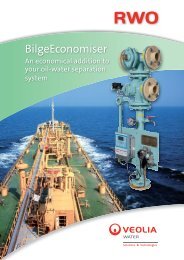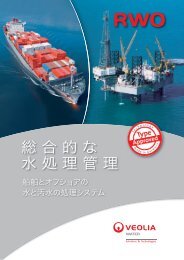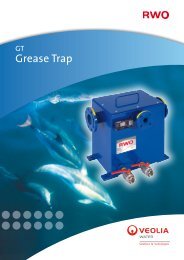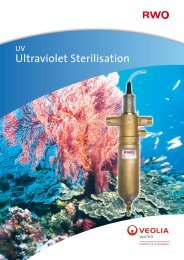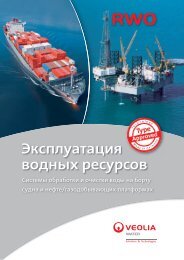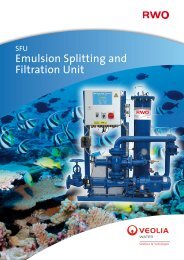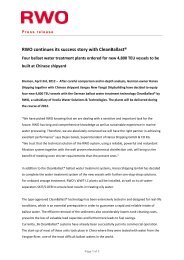the IHS Ballast Water Guide - RWO Marine Water Technology
the IHS Ballast Water Guide - RWO Marine Water Technology
the IHS Ballast Water Guide - RWO Marine Water Technology
Create successful ePaper yourself
Turn your PDF publications into a flip-book with our unique Google optimized e-Paper software.
<strong>IHS</strong> Fairplay Solutions <strong>Guide</strong> to <strong>Ballast</strong> <strong>Water</strong> Treatment Systems Sponsored by<br />
<strong>RWO</strong> recently acquired a means of cutting<br />
out <strong>the</strong> time-consuming work and expense<br />
of surveying, and acquiring an exact digital<br />
reproduction of <strong>the</strong> space conditions on<br />
board ship, accurate to <strong>the</strong> millimetre.<br />
When surveying <strong>the</strong> location in which <strong>the</strong><br />
Clean<strong>Ballast</strong> system is to be installed, a highspeed<br />
360° scanner is used to create a threedimensional<br />
image of <strong>the</strong> ship’s engine room,<br />
which allows <strong>the</strong> most advantageous options<br />
for <strong>the</strong> installation to be ascertained.<br />
Neo-Purimar<br />
Samsung HI 2 7<br />
The Neo-Purimar system from Samsung<br />
Heavy Industries treats ballast on <strong>the</strong><br />
uptake and discharge in a two-stage system.<br />
A 50µm self-cleaning filter removes<br />
particles, sediments and organisms during<br />
ballast uptake before being disinfected by<br />
electrolysis-based chlorination.<br />
To minimise <strong>the</strong> use of <strong>the</strong> chlorine<br />
compound NaOCl, sodium hypochlorite<br />
solution generated from <strong>the</strong> electrolysis<br />
unit is injected to maintain a maximum<br />
chlorine concentration of 10mg per litre total<br />
residual oxidants. <strong>Water</strong> being deballasted<br />
is treated by additional disinfection – <strong>the</strong><br />
sodium hypochlorite solution generated<br />
from <strong>the</strong> electrolysis unit is re-injected – and<br />
by neutralisation, by means of a sodium<br />
thiosulfate solution.<br />
Hydrogen gas, a by-product of <strong>the</strong><br />
electrochemical process, is separated<br />
immediately upon exiting from <strong>the</strong><br />
electrolytic cell by cyclone separation and is<br />
not allowed to enter into <strong>the</strong> ballast water<br />
piping. The gas is <strong>the</strong>n transmitted to a degassing<br />
tank, which dilutes <strong>the</strong> gas to 1% (well<br />
below <strong>the</strong> 4% lower explosive limit) before<br />
exhausting to atmosphere.<br />
BalPure<br />
Severn Trent de Nora 2 7<br />
BalPure, from <strong>the</strong> US joint venture of<br />
Severn Trent Services and Gruppo DeNora,<br />
only treats ballast during <strong>the</strong> uptake on<br />
<strong>the</strong> ballasting operation although a second<br />
operation during de-ballasting is done to<br />
neutralise and residual oxidants remaining<br />
from <strong>the</strong> treatment stage.<br />
<strong>Ballast</strong> water is first cleared of larger<br />
organisms and sediments by a 40µm filter.<br />
Once filtered, a slip stream of 1% of <strong>the</strong><br />
total water ballast uptake flow rate is fed to<br />
<strong>the</strong> BalPure system where a hypochlorite<br />
disinfection solution is generated.<br />
The mixture of seawater, disinfection<br />
solution and hydrogen gas (a by-product of<br />
<strong>the</strong> electrolytic process) <strong>the</strong>n passes through<br />
a cyclone-type degas separator to remove <strong>the</strong><br />
hydrogen gas. The 1% slip stream, now free of<br />
hydrogen, is mixed with <strong>the</strong> remaining 99%<br />
of <strong>the</strong> main uptake flow and used to disinfect<br />
<strong>the</strong> entire volume of ballast water.<br />
The total ballast water flow is <strong>the</strong>n<br />
transferred to <strong>the</strong> ballast tanks. A residual<br />
disinfectant continues to treat <strong>the</strong> ballast<br />
water during <strong>the</strong> voyage.<br />
The BalPure system is used only in<br />
deballasting operations to neutralise <strong>the</strong><br />
residual oxidant in <strong>the</strong> ballast water before<br />
discharging it from <strong>the</strong> ship.<br />
On deballasting, <strong>the</strong> filter is bypassed and<br />
all treated ballast water is discharged. Before<br />
overboard discharge takes place, an automatic<br />
neutralisation process occurs.<br />
A separate, small stream of a neutralisation<br />
agent, sodium bisulphite (7.5 litres per<br />
1,000m 3 ), is automatically added at <strong>the</strong> inlet<br />
of <strong>the</strong> ballast pump and any o<strong>the</strong>r discharge<br />
systems such as aft peak tank systems.<br />
Seawater is <strong>the</strong>n discharged back to <strong>the</strong><br />
marine environment.<br />
32 © <strong>IHS</strong> Global Limited 2012<br />
012_037_CorrectedBW1204.indd 32 01/08/2012 15:36:55



